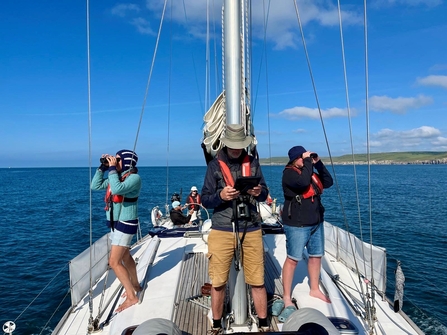Day 1: Plymouth to Dartmouth
We set off early to Queen Anne’s Battery marina to meet Beth from the University of Plymouth. She guided us to Take the Helm, the university’s 13.5-metre sailing yacht used since 2017 for cetacean surveys. After stowing our gear and a safety briefing from skipper Andy, Beth explained the survey protocols before leaving us in the capable hands of Dr. Simon Ingram.
As we sailed out of the harbour, we practiced estimating distances—an essential skill for recording sightings. Once in open water, we rotated survey roles every 30 minutes: two observers and one recorder at the bow, while others took breaks or steered the boat along a plotted course, which I was surprised (and nervous) to do early on! In addition to marine mammals, we recorded birds, boat traffic, jellyfish, buoys, and litter. The calm seas and sunshine made for great conditions, though glare was a challenge.
Our first day yielded sightings of many Manx shearwaters, a grey seal, and a fleeting harbour porpoise. The highlight came later with three encounters of short-beaked common dolphins, including juveniles bow-riding our boat’s wake—an unforgettable experience. We ended the day moored in Dartmouth, ready for the days ahead.


